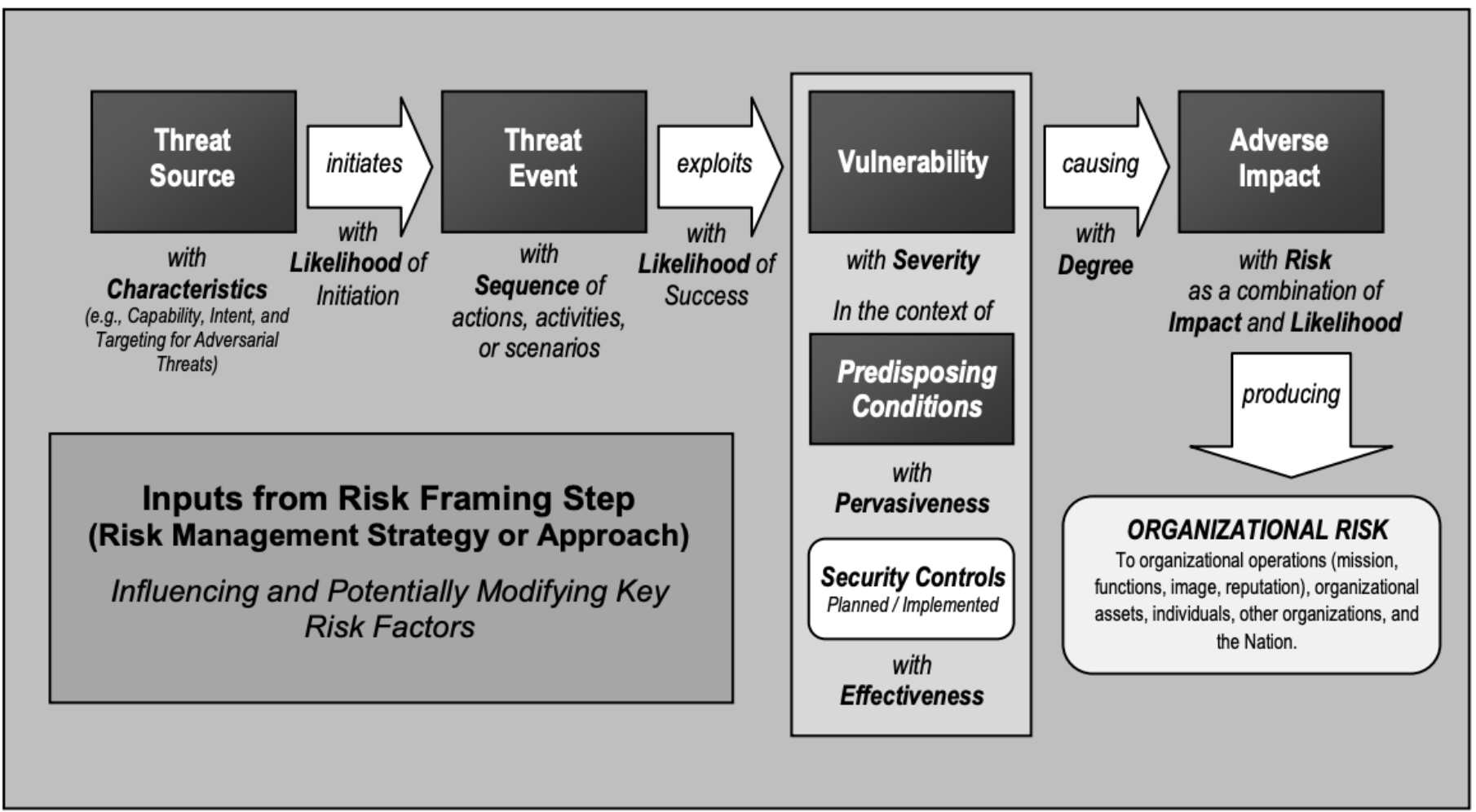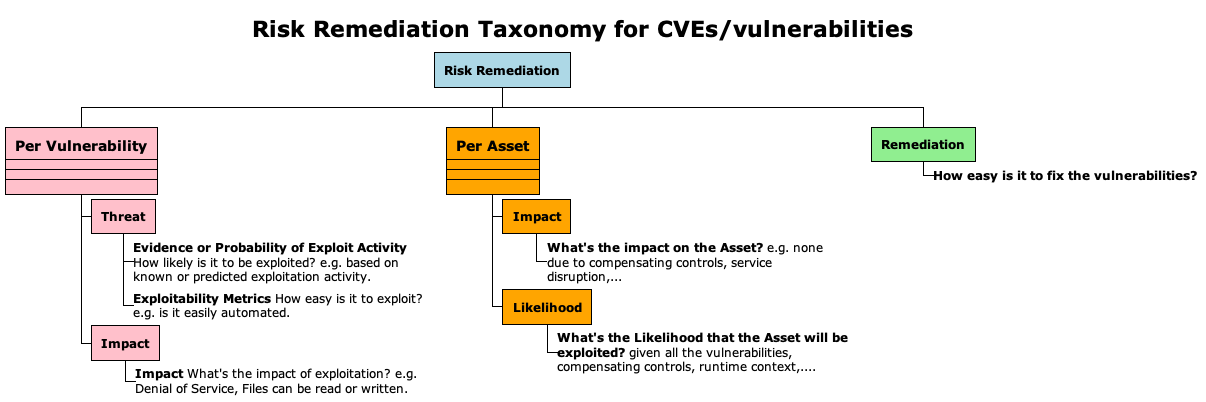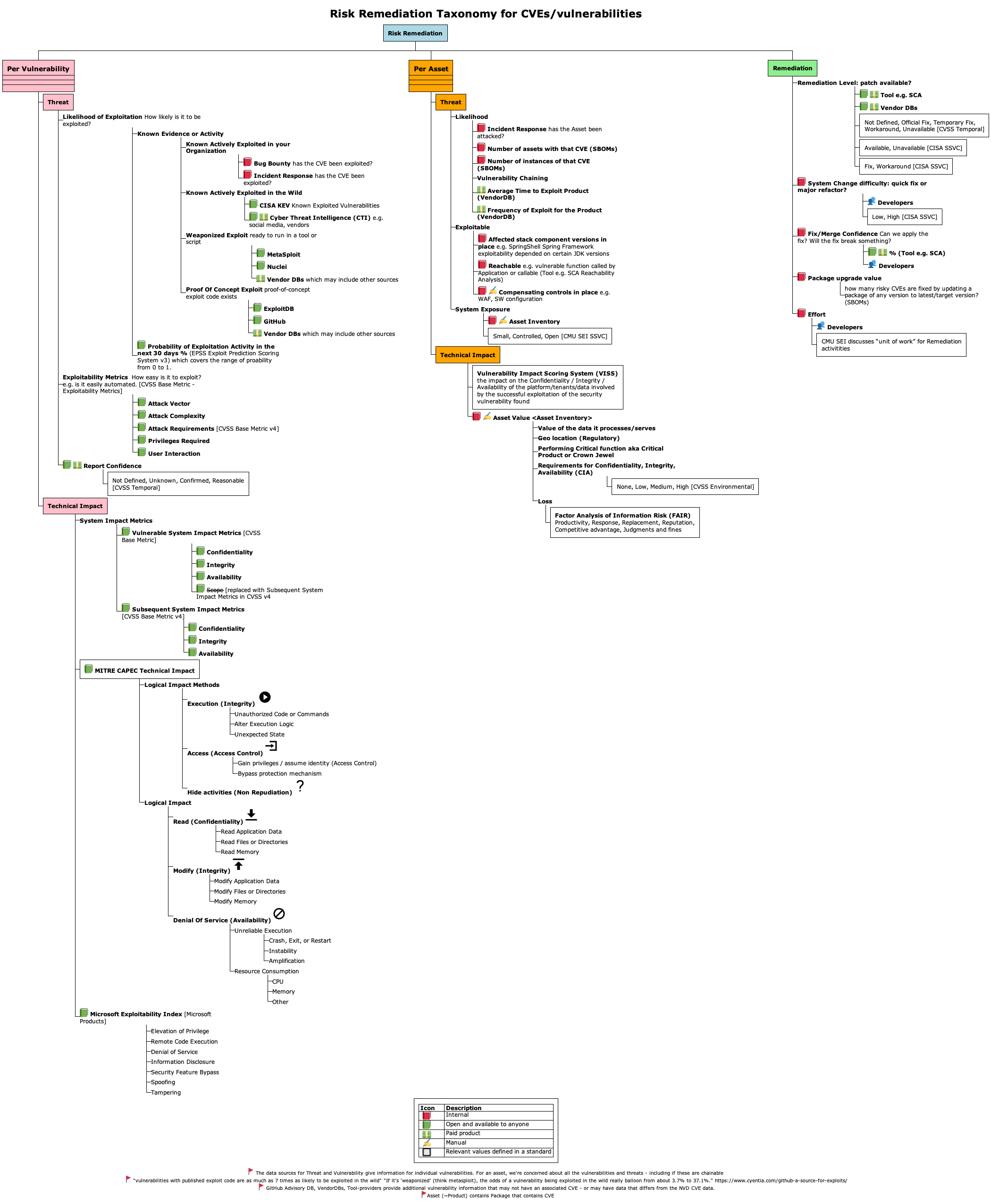Understanding Risk¶
Overview
To understand how to Prioritize CVEs by Risk, we need to understand Risk, and how we can use the building blocks (standards, key risk factors) to inform risk.
This section gives a
- Definition of Risk and the key risk factors
- Risk Taxonomy or orientation map, showing where CVSS, CISA KEV, EPSS fit
- The different data sources that can be used to inform the key risk factors
Risk Definition¶
Risk Definition from NIST Special Publication 800-30 r1 Guide for Conducting Risk Assessments
Risk is per Asset and depends on Impact of a Vulnerability being exploited by a Threat
- RISK A measure of the extent to which an
entity is threatened by a potential circumstance or event, and
typically is a function of:
- the adverse impact, or magnitude of harm, that would arise if the circumstance or event occurs; and
- the likelihood of occurrence.
- Threat the potential for a threat-source to successfully exploit a particular information system vulnerability.
- Vulnerability Weakness in an information system, system security procedures, internal controls, or implementation that could be exploited by a threat source
- Impact The magnitude of harm that can be expected to result from the consequences of unauthorized disclosure of information, unauthorized modification of information, unauthorized destruction of information, or loss of information or information system availability.
- Asset The data, personnel, devices, systems, and facilities that enable the organization to achieve business purposes.

Risk Remediation Taxonomy¶

"Risk Remediation Taxonomy based on a BSides Conference presentation"
Risk is per Asset and depends on the Impact of a Vulnerability being exploited by a Threat
- The Vulnerability branch indicates there can be multiple
vulnerabilities for a given Asset
- Each vulnerability can be considered separately with its
associated Threat and Impact
- The Threat ("the potential for a
threat-source to successfully exploit a particular
information system vulnerability") depends on
- Evidence of Exploit activity, or Probability of Exploit
activity
- e.g. a vulnerability is known actively exploited in the wild
- e.g. a vulnerability has no known exploitation or known proof of concept or any known implementation
- The Exploitability of the Vulnerability
- e.g. a vulnerability that can be exploited remotely automatically via a generic tool/script with no permissions or user interaction required has high Exploitability.
- e.g. a vulnerability that requires local access, special permissions, bypass of a security feature, and user interaction, has low Exploitability.
- Evidence of Exploit activity, or Probability of Exploit
activity
- The Threat ("the potential for a
threat-source to successfully exploit a particular
information system vulnerability") depends on
- Each vulnerability can be considered separately with its
associated Threat and Impact
- The Asset branch is for one Asset
- An Asset can be impacted by multiple Vulnerabilities and Threats (the Vulnerability and Threat red boxes include multiple sections to convey there are multiple)
- Likelihood of Exploitation can also be viewed from an Asset point of view also (i.e. for all Threats and Vulnerabilities that affect that asset)
- Remediation
- Remediation is part of the overall Risk Remediation picture - but will not be covered here.
Risk Remediation Taxonomy Detailed¶

Where CVSS, EPSS, CISA KEV Fit¶
Adding more detail to the Vulnerability branch, to show where CVSS, EPSS, CISA KEV fit...

Threat Likelihood of Exploitation Data Sources¶
The Threat "Likelihood of Exploit" branch items are arranged by most likely on top
- Known Actively Exploited in your organization
- If a Vulnerability was previously exploited in your organization, then it's reasonable to think that Vulnerability is most likely to be exploited again in your organization in the future.
- Known Actively Exploited in the wild
- CISA KEV lists a subset of known actively exploited Vulnerabilities in the wild.
- VulnCheck KEV lists additional known actively exploited Vulnerabilities in the wild (and includes CISA KEV CVEs)
- There isn't an authoritative common public list of ALL Vulnerabilities that are Known Actively Exploited in the wild.
- Weaponized Exploit
- A Vulnerability with a "Weaponized Exploit" (but not yet Known
Exploited) is more likely to be exploited than a Vulnerability
with "Proof Of Concept Exploit" available
- "vulnerabilities with published exploit code are as much as 7 times as likely to be exploited in the wild"
- "If it’s ‘weaponized’ (think metasploit), the odds of a vulnerability being exploited in the wild really balloon from about 3.7% to 37.1%." Per Jay Jacobs, Cyentia
- A Vulnerability with a "Weaponized Exploit" (but not yet Known
Exploited) is more likely to be exploited than a Vulnerability
with "Proof Of Concept Exploit" available
- Proof Of Concept Exploit
- ExploitDB is an example of where Vulnerability Proof Of Concept Exploits are available.
- EPSS Probability of Exploitation
- The EPSS score covers the range of Likelihood of Exploitation from 0 to 100%.
Why Should I Care?¶
Prioritizing by exploitation reduces cost and risk
Prioritizing vulnerabilities that are being exploited in the wild, or are more likely to be exploited, reduces the
- cost of vulnerability management
- risk by reducing the time adversaries have access to vulnerable systems they are trying to exploit
Quote
-
"many vulnerabilities classified as “critical” are highly complex and have never been seen exploited in the wild - in fact, less than 4% of the total number of CVEs have been publicly exploited" (see BOD 22-01: Reducing the Significant Risk of Known Exploited Vulnerabilities).
Cybersecurity and Infrastructure Security Agency emphasizes prioritizing remediation of vulnerabilities that are known exploited in the wild:
-
"As a top priority, focus your efforts on patching the vulnerabilities that are being exploited in the wild or have competent compensating control(s) that can. This is an effective approach to risk mitigation and prevention, yet very few organizations do this. This prioritization reduces the number of vulnerabilities to deal with. This means you can put more effort into dealing with a smaller number of vulnerabilities for the greater benefit of your organization's security posture."
How Many Vulnerabilities are Being Exploited?¶
Only about 5% or fewer of all CVEs have been exploited
- “Less than 3% of vulnerabilities have weaponized exploits or evidence of exploitation in the wild, two attributes posing the highest risk,” Qualys
- “Only 3 percent of critical vulnerabilities are worth prioritizing,” https://www.datadoghq.com/state-of-application-security/
- “Less than 4% of the total number of CVEs have been publicly exploited”, CISA KEV
- “We observe exploits in the wild for 5.5% of vulnerabilities in our dataset,” Jay Jacobs, Sasha Romanosky, Idris Adjerid, Wade Baker
In contrast, for CVSS (Base Scores):
- ~15% of CVEs are ranked Critical (9+)
- ~65% of CVEs are ranked Critical or High (7+)
- ~96% of CVEs are ranked Critical or High or Medium (4+)
What Vulnerabilities are Being Exploited?¶
There isn't an authoritative common public list of ALL CVEs that are Known Actively Exploited in the wild
There is considerable variation in the
- Total Number of Vulnerabilities being Exploited from different sources (per above)
- The criteria for "Known Actively Exploited in the wild".
CISA KEV includes a subset of Vulnerabilities that are Known-Exploited in the wild.
CISA KEV currently includes ~1.1K CVEs, and defines criteria for inclusion
CISA Known Exploited Vulnerabilities Catalog (CISA KEV) is a source of vulnerabilities that have been exploited in the wild
There's several criteria including:
Quote
"A vulnerability under active exploitation is one for which there is reliable evidence that execution of malicious code was performed by an actor on a system without permission of the system owner."
"Events that do not constitute as active exploitation, in relation to the KEV catalog, include:
- Scanning
- Security research of an exploit
- Proof of Concept (PoC)
EPSS provides a probability of exploitation for all published CVEs (in the next 30 days)
For EPSS, the criteria for exploit evidence (used to feed the model) is a detection of traffic matching an intrusion detection/prevention systems (IDS/IPS), or honeypot, signature (not a successful exploitation).
Scanning would likely trigger a detection. In contrast, For CISA KEV, scanning does not constitute as active exploitation.
Various CTI lists other Known-Exploited CVEs
There are numerous Cyber Threat Intelligence sources e.g. vendors, publicly available data, that provide lists of CVEs that are Known-Exploited in addition to those listed on CISA KEV.
CVSS¶
CVSS Base Score should not be used alone to assess risk!
CVSS Base Score¶
Quote
CVSS Base (CVSS-B) scores are designed to measure the severity of a vulnerability and should not be used alone to assess risk. https://www.first.org/cvss/v4.0/user-guide#CVSS-Base-Score-CVSS-B-Measures-Severity-not-Risk
The CVSS Base score is not a good indicator of likelihood of exploit (it is not designed or intended to be)
- "There’s no inherent correlation between the vulnerability and if threat actors are exploiting them in terms of those severity ratings" Gartner, Nov 2021
- "CVSS score performs no better than randomly picking vulnerabilities to remediate and may lead to negligible risk reductions" Comparing Vulnerability Severity and Exploits Using Case-Control Studies, 2014
Quote
The Base metric group represents the intrinsic characteristics of a vulnerability that are constant over time and across user environments. It is composed of two sets of metrics: the Exploitability metrics and the Impact metrics.
- The Exploitability metrics reflect the ease and technical means by which the vulnerability can be exploited. That is, they represent characteristics of the “thing that is vulnerable”, which we refer to formally as the “vulnerable system”.
- The Impact metrics reflect the direct consequence of a successful exploit, and represent the consequence to the “things that suffer the impact”, which may include impact on the vulnerable system and/or the downstream impact on what is formally called the “subsequent system(s)”.
The CVSS Threat Metric Group contains an Exploit Maturity but it is the responsibility of the CVSS Consumer/user to populate the values
CVSS Exploit Maturity¶
See section CVSS Exploit Maturity for more details.
Quote
This metric measures the likelihood of the vulnerability being attacked, and is based on the current state of exploit techniques, exploit code availability, or active, “in-the-wild” exploitation. Public availability of easy-to-use exploit code or exploitation instructions increases the number of potential attackers by including those who are unskilled. Initially, real-world exploitation may only be theoretical. Publication of proof-of-concept exploit code, functional exploit code, or sufficient technical details necessary to exploit the vulnerability may follow. Furthermore, the available exploit code or instructions may progress from a proof-of-concept demonstration to exploit code that is successful in exploiting the vulnerability consistently. In severe cases, it may be delivered as the payload of a network-based worm or virus or other automated attack tools.
The Threat Likelihood of Exploitation Data Sources can be used here.
If there is an absence of exploitation evidence, then EPSS can be used to estimate the probability it will be exploited
EPSS and Exploitation Evidence¶
"If there is evidence that a vulnerability is being exploited, then that information should supersede anything EPSS has to say, because again, EPSS is pre-threat intel. If there is an absence of exploitation evidence, then EPSS can be used to estimate the probability it will be exploited." https://www.first.org/epss/faq
The "Known Evidence or Activity branch" lists data sources where we can get that evidence of exploitation.
Zero Days¶
Quote
EPSS scores won’t be available for Zero Days (because EPSS depends on the CVE being published and it can take several days for the associated CVE to be published).
"The State of Exploit Development: 80% of Exploits Publish Faster than CVEs".
Quote
A zero-day vulnerability is a flaw in software or hardware that is unknown to a vendor prior to its public disclosure, or has been publicly disclosed prior to a patch being made available. As soon as a zero day is disclosed and a patch is made available it, of course, joins the pantheon of known vulnerabilities.
Don’t go chasing zero days, patch your known vulnerabilities instead….
Vulnerabilities increase risk, whether or not they start as zero days. We advise organizations to operate with a defensive posture by applying available patches for known, exploited vulnerabilities sooner rather than later.
Quote
Zero day vulnerabilities made up only approximately 0.4% of vulnerabilities during the past decade. The amount spent on trying to detect them is out of kilter with the actual risks they pose. This is compared with the massive numbers of breaches and infections that come from a small number of known vulnerabilities that are being repeatedly exploited. As a top priority, focus your efforts on patching the vulnerabilities that are being exploited in the wild or have competent compensating control(s) that can. This is an effective approach to risk mitigation and prevention, yet very few organizations do this.
Focus on the Biggest Security Threats, Not the Most Publicized, Gartner, Nov 2017
Takeaways
- CVSS or EPSS should not be used alone to assess risk - they can be used together:
- CVSS Base Score is a combination of Exploitability and Impact
- Various data sources can be used as evidence of exploitation activity or likelihood of exploitation activity - but there isn't
- a single authoritative source
- an industry standard on how to do this
- EPSS should be used with other exploitation evidence; if there is an absence of exploitation evidence, then EPSS can be used to estimate the probability it will be exploited.
- EPSS scores won't be available for Zero-Days
- "Don’t go chasing zero days, patch your known vulnerabilities instead"
- It is the responsibility of the CVSS Consumer/user to populate the CVSS Exploit Maturity values i.e. unlike the CVSS Base Score, these are not provided.
- Criteria for "Exploitation" are different for EPSS and CISA KEV.
